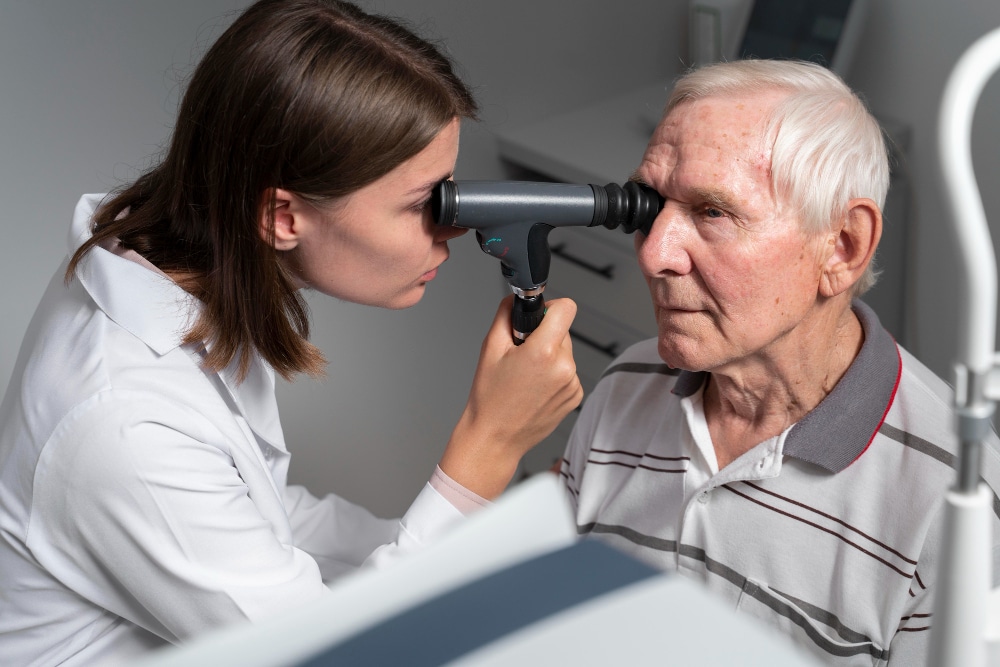Cataracts, one of the leading causes of vision impairment worldwide, arise from the clouding of the eye’s natural lens. These occlusions develop gradually, transforming clear vision into a blurry or foggy haze, complicating everyday tasks. Often linked to aging, they can also be influenced by various genetic, environmental, and lifestyle factors. Grasping the causes, symptoms, treatment options, and preventive measures is essential, not just for affected individuals but for everyone aiming to maintain optimal eye health throughout their lives.
Common Causes
The clouding of the lens within the eye impedes the transmission of light and ultimately affects vision. The lens, situated behind the iris, plays a pivotal role in refracting and focusing light on the retina, ensuring crisp and clear images. The factors that can trigger the formation of cataracts include:
Aging:
As years go by, the proteins in our eye’s lens begin to break down. This deterioration causes these proteins to aggregate, leading to the lens becoming opaque or cloudy. This cloudiness, over time, can impede normal vision, making routine tasks challenging.
Hereditary Conditions:
Genetics plays a significant role in numerous health issues. Individuals with a family history are often more susceptible. Certain genetic patterns can predispose some families to develop them earlier or more rapidly than others.
Medical Disorders:
Conditions like diabetes and myotonic dystrophy heighten the risk. Elevated blood sugar levels, for example, can result in metabolic changes in the lens, promoting their onset.
Ocular Trauma:
Physical injuries, whether from accidents or sports, can prompt their development. Traumatic impacts might disrupt lens fibers, and interestingly, onset can sometimes emerge years post-injury.
Symptoms
The clinical manifestations of cataracts vary based on their location and type, but the common symptoms are:
Blurred Vision:
One of the primary indications is a subtle blurring of vision. This is akin to looking through a fogged-up window. Everyday objects and surroundings might start appearing less clear. Those experiencing such symptoms might consider an online Ophthalmology consultation for professional guidance and intervention.
Sensitivity to Light:
As cataracts progress, there can be heightened sensitivity to bright lights. This is particularly noticeable during nighttime driving, where headlights might appear excessively glaring. Halos might also manifest around light sources, making daily tasks more challenging.
Color Distortion:
With the progression of cataracts, there’s a noticeable shift in color perception. Colors that once appeared vibrant might seem dull or have a yellowish tint. This change can affect daily activities, such as reading or distinguishing between colors.
Prescription Changes:
A frequent or sudden need to alter eyeglasses or contact lens prescriptions can be an indication. As the lens becomes opaque, vision changes, necessitating updates in corrective eyewear for clearer sight.
Double Vision:
Monocular diplopia, or double vision in one eye, can be a symptom of cataracts. This effect makes images appear overlaid or duplicated, and it can be particularly disorienting. This shouldn’t be confused with binocular diplopia, which involves both eyes and is caused by alignment issues.
Diagnosis
Regular eye examinations are imperative for timely detection and intervention. During an ophthalmic examination, a healthcare professional assesses visual acuity, and light refraction, and uses specialized instruments to inspect the lenses, retina, and other eye structures. With online GP registration, patients can easily schedule frequent eye check-ups, aiding in early detection and management. Advanced imaging techniques can offer more detailed insights, ensuring a comprehensive understanding of the condition’s severity. Early diagnosis paves the way for effective management strategies and helps patients make informed decisions about their care.
Treatment Options
In their initial stages, they might not be overly disruptive, and symptoms can be addressed using corrective eyewear, increased illumination, or, in advanced cases, surgical interventions. Through Online doctor consultations on Consultdoc, you would be provided with professional medical advice and tailored treatment intervention effectively.
Corrective Eyewear:
In the early stages of cataracts, vision disturbances can often be addressed using glasses or contact lenses. These aids can offer a temporary solution, enhancing vision clarity and compensating for the lens’s cloudiness.
Increased Illumination:
Amplifying surrounding light can help those experiencing challenges, especially during reading or other tasks. Brighter environments can mitigate some of the vision challenges in the early stages. Seeking advice through online GP services can guide individuals to suitable treatment intervention and measures.
Surgical Intervention:
For mature and vision-affecting cases, the most recommended solution is cataract surgery. This procedure entails the removal of the clouded lens and its replacement with a synthetic, clear lens, restoring vision.
Post-operative Care:
After surgery, patients are typically prescribed eye drops to prevent infection and reduce inflammation. Protective eyewear is also recommended to shield from potential irritants and ensure healing.
Preventive Measures
While some factors like aging are inevitable, certain measures can be taken to reduce the risk or delay its onset. Adopting a nutritious diet rich in antioxidants can protect the eyes from oxidative damage. Frequent eye check-ups aid in early detection and management. Guarding the eyes against excessive UV exposure with sunglasses and minimizing direct sun exposure during peak hours is also vital. Lifestyle changes, such as quitting smoking and moderating alcohol consumption, play a significant role in eye health.
Conclusion
Cataracts, often tied to the natural aging process, can significantly alter our daily experiences. Nevertheless, with the leaps in medical technology, there are potent treatments available, and there’s a rising focus on preventive measures. Community awareness initiatives and informative programs are invaluable in providing people with the necessary insights to value and defend their eyesight. Regular eye care, combined with a proactive approach to health and lifestyle choices, remains crucial for maintaining optimal eye health.
